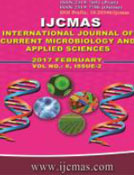


 National Academy of Agricultural Sciences (NAAS)
National Academy of Agricultural Sciences (NAAS)

|
PRINT ISSN : 2319-7692
Online ISSN : 2319-7706 Issues : 12 per year Publisher : Excellent Publishers Email : editorijcmas@gmail.com / submit@ijcmas.com Editor-in-chief: Dr.M.Prakash Index Copernicus ICV 2018: 95.39 NAAS RATING 2020: 5.38 |
Raising confined poultry generates waste that causes environmental problems, and that requires special handling in order to minimize these impacts. Poultry litter contains bird feces and feathers, spilled feed and the moisture-absorbing material used on the floor of the cages. This results in a residue with a high concentration of nutrients that may impact the soil due to the wide availability of poultry litter. The poultry litter and the produced biofertilizer was characterized chemically and subsequently evaluated in three treatments, namely: T1 - poultry litter + cattle biofertilizer + water; T2 - poultry litter + biofertilizer, and T3 - poultry litter + water, so as to determine the three treatments' ability to produce biogas. The obtained results reveal that the poultry litter is composed of nitrogen, phosphorus, potassium, calcium, magnesium and sulfates. The produced biofertilizer proved to be rich in macro and micronutrients, highlighting nitrogen, phosphorus, potassium, calcium, magnesium, sodium, iron, boron, copper, zinc and manganese. The pH of the biofertilizer varied from 6.58 to 8.02. The macro and micronutrients of the produced biofertilizers differed statistically among themselves in the effluents evaluated in relation to the affluent of the system. The levels of nitrogen and phosphorus were the ones with the highest results in the PL+B treatment, differing significantly from the treatments PL+B+W and PL+A. This allows for the conclusion that the use of poultry litter biomass is a viable alternative for the production of biogas and biofertilizers, potentially replacing the use of chemical fertilizers in the poultry farms.
 |
 |
 |
 |
 |